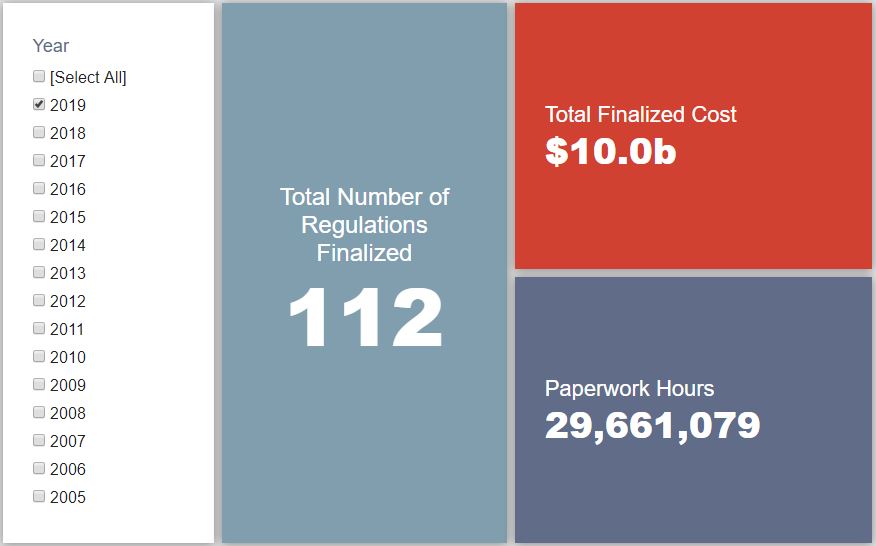Week in Regulation
June 24, 2019
Regulatory Budgeting Gets Complicated
The most notable action of the week was the Environmental Protection Agency (EPA) releasing the final version of its Clean Power Plan (CPP) replacement: the Affordable Clean Energy (ACE) rule. While that rule still awaits final publication in the Federal Register, it and another rulemaking published last week raise interesting questions about the mechanics of a regulatory budget. Across all proposed and final rules, agencies published $30.7 million in total net costs and added 890,943 hours of paperwork.
REGULATORY TOPLINES
- New Proposed Rules: 36
- New Final Rules: 90
- 2019 Total Pages: 29,309
- 2019 Final Rule Costs: $10 Billion
- 2019 Proposed Rule Costs: $1.7 Billion
TRACKING THE REGULATORY BUDGET
In terms of final rules that officially count toward the fiscal year (FY) 2019 regulatory budget under Executive Order (EO) 13,771, there was one rule that affected the overall tally. The rule, promulgated jointly by the Departments of Health and Human Services and Labor, and the Internal Revenue Service (the Agencies), opens up further consumer access to Health Reimbursement Accounts (HRAs). The American Action Forum’s (AAF) Jonathan Keisling provides a deeper dive into the rule’s implications here. For regulatory budgeting purposes, however, it is a curious case. The Agencies deem it to be a deregulatory action under 13,771, but the only quantified economic effects come from the new paperwork burdens involved. The economic analysis includes some qualitatively deregulatory effects, yet in terms of tabulating it in the scheme of the regulatory budget, it still comes out to net-costs.
So far in FY 2019 (which began on October 1, 2018), there have been 50 deregulatory actions (per the rubric created by EO 13,771 and the administration’s subsequent guidance document) against 27 rules that increase costs and fall under the EO’s reach. Combined, these actions yield quantified net costs of roughly $10.9 billion. This total, however, includes the caveat regarding the baseline in the Department of Agriculture’s “National Bioengineered Food Disclosure Standard.” If one considers that rule to be deregulatory, the administration-wide net total is approximately $4.2 billion in net costs. The administration’s cumulative savings goal for FY 2019 is approximately $18 billion.
EPA’s ACE rule was the most notable regulatory action of the week. Although, since it is not yet in the Federal Register, it does not yet accrue to the regulatory budget. When it does, it will have a sizable impact – just not in the way one may think. As laid out here, while repeal of the CPP was long heralded as one of the key deregulatory actions of this administration, the actual vehicle for that action (the ACE rule) comes out as a regulatory action. The nearly $1 billion in new costs creates a swing in the expected budget in the tens of billions of dollars. Considering the current net cost total across all agencies, the administration has a lot of work to do in order to get to $18 billion in net savings – and only about 3 months to do it.
THIS WEEK’S REGULATORY PICTURE
This week, we examine an executive order to reduce the number of federal advisory committees.
Federal advisory committees are designed to offer expertise and advice to assist federal agencies in their policy decisions. According to the General Services Administration (GSA), there are currently 1,063 such committees. The chart below shows these committees broken down by how they are authorized.

This week, the Federal Register published an EO titled “Evaluating and Improving the Utility of Federal Advisory Committees,” signed by President Trump on June 14. It aims to make a substantial reduction in the number of federal advisory committees that are not required by statute by requiring agencies to eliminate one-third of the 462 such committees.
The EO directs agencies to evaluate the need for their current committees and terminate at least one-third of their non-statutorily required committees by September 30, 2019. The EO also sets an administration-wide cap on such committees at 350. If an agency wants to add a new committee that would take the federal count over that cap, it must get a waiver from the Office of Management and Budget.
Though the reasons for the EO are not included in the order itself, during the signing of the EO President Trump told the assembled press that some committees are obsolete or have costs that outweigh their benefits. According to GSA, the total cost of all federal advisory committees is about $385 million per year.
Critics of the move argued that the EO is an effort to reduce scientific expertise at federal agencies. While the most important scientific committees are statutorily required (such as the EPA‘s Science Advisory Board), some are not (such as EPA’s Clean Air Scientific Advisory Committee). For an administration that has taken criticism over how it values science on issues like climate change, it is fair to wonder whether the effort to reduce advisory committees is worth the political headache even it does reduce the costs to taxpayers.
TOTAL BURDENS
Since January 1, the federal government has published $11.6 billion in net costs (with $10 billion in finalized costs) and 32.5 million hours of net paperwork burden increases (with 29.6 million coming from final rules). Click here for the latest Reg Rodeo findings.












